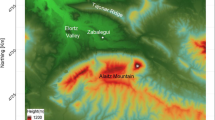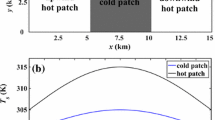Abstract
Reasons for the nonclosure of the heat balance in the atmospheric boundary layers over natural land surfaces are analyzed. Results of measuring the heat-balance components over different land surfaces are used. The Cabauw (Netherlands) data (obtained throughout 1996 over a grass surface with intermittent shrubs and single trees) and the data from the Anchor station in Germany (measured over coniferous forest in 2000–2001) are analyzed. In all, the analysis involves about fifty thousand independent values of the heat-balance components measured in the experiments, which should be indicative of the reliability of the results obtained in the paper. The data have shown that the heat balance is not closed and the imbalance is 50–250 W/m2. The sum of the latent and sensible heat fluxes λE + H = STF is found to be systematically smaller than the difference between the net radiation and the heat flux into the ground R n − G. It is shown that the main cause of a systematic heat imbalance in the atmospheric boundary layers over inhomogeneous land surfaces is that the methods of surface-flux measurement and estimation are based on the theory that requires the hypothesis of stationarity and horizontal homogeneity. Direct data analysis has shown that the heat imbalance increases with landscape inhomogeneity. In the paper, a parametrization of the heat imbalance is carried out and the coefficient k f (z ef0 /L ef) is introduced as a measure of inhomogeneity. For this, data from the experiments FIFE, KUREX, TARTEX, SADE, etc., are also used. Empirical formulas are presented to refine the results of direct measurements and calculations of surface fluxes over natural (inhomogeneous) land surfaces from profile and standard (using bulk parametrizations) data. These formulas can also be used to determine surface fluxes over inhomogeneous underlying land surfaces in order to take into account so-called subgrid-scale effects in constructing prediction models.
Similar content being viewed by others
References
J. R. Garratt, The Atmospheric Boundary Layer (Cambridge Univ. Press, Cambridge, 1992).
E. T. Kanemasu, S. B. Verma, E. A. Smith, et al., “Surface Flux Measurements in FIFE: An Overview,” J. Geophys. Res. D 97(17), 18547–18555 (1992).
A. S. Monin and A. M. Yaglom, Statistical Fluid Mechanics (MIT, Cambridge, 1971; Gidrometeoizdat, St. Petersburg, 1992).
J. A. Businger, J. A. Wyngaard, Y. Izumi, et al., “Flux-Profile Relationships in the Atmospheric Surface Layer,” J. Atmos. Sci. 28, 181–189 (1971).
J. C. Kaimal, J. C. Wyngaard, Y. Izumi, et al., “Spectral Characteristics of Surface-Layer Turbulence,” Q. J. R. Meteorol. Soc. 98, 563–589 (1972).
B. A. Kader and A. M. Yaglom, “Heat and Mass Transfer Laws for Fully Turbulent Wall Flows,” Int. J. Heat Mass Transfer 15, 2329–2353 (1972).
W. Brutsaert, Evaporation into the Atmosphere: Theory, History and Applications (Reidel, Dordrecht, 1982).
G. N. Panin, Heat and Mass Exchange between a Water Body and the Utmosphere under Natural Conditions (Nauka, Moscow, 1985) [in Russian].
R. B. Stull, An Introduction to Boundary Layer Meteorology (Kluwer, Dordrecht, 1988).
L. G. Elagina, S. L. Zubkovskii, B. M. Koprov, and D. Yu. Sokolov, “Experimental Study of the Heat Balance on the Soil Surface,” in Trudy GGO, No. 296: Complex Energetics Experiment (KONEKS-71) (Gidrometeoizdat, Leningrad, 1973) [in Russian].
L. Mahrt, “Flux Sampling Errors for Aircraft and Towers,” J. Atmos. and Ocean. Technol. 15, 416–429 (1998).
G. N. Panin, G. Tetzlaff, and A. Raabe, “Inhomogeneity of the Land Surface and Problem in Parametrization of the Surface Fluxes in Natural Conditions,” Theor. Appl. Clim. 60, 163–178 (1998).
M. I. Mordukhovich and L. R. Tsvang, “Direct Measurements of Turbulent Fluxes at Two Heights in the Surface Air Layer,” Izv. Akad. Nauk SSSR, Fiz. Atmos. Okeana 2(8), 786–803 (1966).
B. M. Koprov and D. Yu. Sokolov, “Experimental Study of Variations in Heat Fluxes in the Surface Air Layer,” Izv. Akad. Nauk SSSR, Fiz. Atmos. Okeana 11(77), 743–747 (1975).
V. P. Kukharets and L. R. Tsvang, “Variations in the Underlying Surface Temperature and the Problem of Closure of the Heat Balance Equations,” Izv. Akad. Nauk, Fiz. Atmos. Okeana 35(2), 207–214 (1999) [Izv., Atmos. Ocean. Phys. 35(2), 188–194 (1999)].
Th. Foken, W. Gerstmann, S. H. Richter, et al., “Study of the Energy Exchange Processes over Different Types of Surface during TARTEX-90,” (DWD, Abteilung Forschung, Arbeitsergebnisse, 1993).
Ch. Bernhofer, L. W. Gay, A. Granier, et al., “The Hart X-Synthesis: An Experimental Approach to Water and Carbon Exchange of a Scots Pine Plantation,” Theor. Appl. Climatol. 53, 173–183 (1966).
G. N. Panin and A. E. Nasonov, “Problems of Measurement, Calculation, and Parametrization of Overland Surface Fluxes,” Izv. Akad. Nauk, Fiz. Atmos. Okeana 32(4), 448–455 (1996) [Izv., Atmos. Ocean. Phys. 32(4), 411–418 (1996)].
G. N. Panin and A. E. Nasonov, “Problems of Measurement and Calculation of Surface Fluxes in KUREX-91 Experiment,” Remote Sensing Rev. 17, 281–290 (1998).
J. Laubach and U. Teichmann, “Surface Energy Budget Variability: A Case Study over Grass with Special Regard to Minor Inhomogeneities in the Source Area,” Theor. Appl. Climatol. 61, 9–24 (1999).
S. Aoki, J. Asanuma, J. Kim, et al., “Scaling Analysis of the Turbulence Heat Transfer over the Tibetan Plateau with Wavelet Transform of the Naqu Flux Site Data during GAME-Tibet IOP’98,” in Proceedings of GAME ANN/Radiation Workshop (Phuket, 2001), pp. 79–80.
J. Kum, Y. Harazono, S. Yamamoto, et al., “Flux Measurements in Complex Landscape: How Reliable and Consistent are Fluxes from a Single Eddy Covariance Tower?” in Proceedings of GAME ANN/Radiation Workshop (Phuket, 2001), pp. 83–84.
G. N. Panin, W. Kohsiek, and A. E. Nasonov, “Interaction between Atmosphere and Natural Land Surface,” in Proceedings of Fifth International Study Conference of GEWEX in Asia and GAME (2001), No. 31, pp. 42–47.
K. Tanaka and H. Ishikawa, “Long-Term Monitoring of Surface Energy Fluxes at Amdo in the Eastern Tibetan Plateau,” in Proceedings of GAME ANN/Radiation Workshop (Phuket, 2001), pp. 40–43.
J. Wang, “The Correction of Flux Measurements in GAME-Tibet,” in Proceedings of GAME ANN/Radiation Workshop (Phuket, 2001), pp. 81–82.
Y. G. Mengesha, P. A. Taylor, and D. H. Lenscow, “Boundary-Layer Turbulence over the Nebraska Sandhills,” Bound.-Layer Meteorol. 100, 3–46 (2001).
D. Cava, U. Giostra, and M. Tagliazucca, “Spectral Maxima in a Perturbed Stable Boundary Layer,” Bound.-Layer Meteorol. 100, 421–437 (2001).
R. K. Sakai, D. R. Fitzjarrald, and K. E. Moore, “Importance of Low-Frequency Contributions to Eddy Fluxes Observed over Rough Surfaces,” Q. J. R. Meteorol. Soc. 118, 191–225 (2001).
J. J. Finnigan, R. Clement, Y. Malhi, et al., “A Re-Evaluation of Longterm Flux Measurement Techniques: Part 1. Averaging and Coordinate Rotation,” Bound.-Layer Meteorol. 107, 1–48 (2003).
J. Finnigan, “Advection and Modelling,” in Handbook on Micrometeorology, Ed. by X. Lee, W. Massman, and B. Law (Kluwer, Dordrecht, 2005), pp. 209–244.
M. Aubinet, P. Berbigier, C. Bernhofer, et al., “Comparing CO2 Storage and Advection Conditions at Night at Different CarboEuroflux Sites,” Bound.-Layer Meteorol. 116, 63–94 (2005).
M. Aubinet, B. Heinesch, and M. Yernaux, “Horizontal and Vertical CO2 Advection in a Sloping Forest,” Bound.-Layer Meteorol. 108, 397–417 (2003).
A. P. Van Ulden and J. Wieringa, “Atmospheric Boundary Layer Research at Cabauw,” Bound.-Layer Meteorol. 78, 39–69 (1996).
J. B. Stewart and A. S. Thom, “Energy Budget in Pine Forest,” Q. J. R. Meteorol. Soc. 99, 154–170 (1973).
R. Van Dorland, P. Stammes, A. A. M. Holtslag, et al., “A Long Wave Radiation Transfer Scheme for Climate Modeling and Its Evaluation with Surface Observations at Cabauw,” in Radiation and Climate. From Radiative Transfer Modeling to Global Temperature Response (ISBN, 1999).
F. Beyrich, S. H. Richter, U. Weisensee, et al., “Experimental Determination of Turbulent Fluxes over the Heterogeneous LITFASS Area: Selected Results from the LITFASS-98 Experiment,” Theor. Appl. Climatol. 73, 19–34 (2002).
T. Foken, M. Göckede, M. Mauder, et al., “Post-Field Data Quality Control,” in Handbook and of Micrometeoroly: A Guide for Surface Flux Measurement Analysis, Ed. by X. Lee, W.J. Massman, and B. Law (Kluwer, Dordrecht, 2004), pp. 181–208.
C. Von Randow, A. O. Manzi, B. Kruijt, et al., “Comparative Measurements and Seasonal Variations in Energy and Carbon Exchange over Forest and Pasture in South West Amazoina,” Theor. Appl. Climatol. 78, 5–26 (2004).
J. C. Kaimal and J. J. Finnigan, Atmospheric Boundary Layer Flows: Their Structure and Measurement (Oxford Univ. Press, New York, 1994).
P. A. Taylor, R. I. Sykes, and P. J. Mason, “On the Parametrization of Drag over Small-Scale Topography in Neutrally Stratified Boundary Layer Flow,” Bound.-Layer Meteorol. 48, 409–422 (1989).
J. S. Bendat and A. G. Piersol, Measurement and Analysis of Random Data (New York, 1967).
O. G. Khutorova and G. E. Korchagin, “Studying the Spatial Structure of Mesoscale Variations in Tropospheric Aerosol by Using Different Methods,” Opt. Atmos. Okeana 14, 630–632 (2001).
G. N. Panin and G. Tetzlaff, “A Measure of Inhomogeneity of the Land Surface and Parametrization of the Turbulent Fluxes in Natural Conditions,” Theor. Appl. Climatol. 62, 3–8 (1999).
J. J. M. De Jong, A. C. de Vries, and W. Klaasen, “Influence of Obstacles on the Aerodynamic Roughness of the Netherlands,” Bound.-Layer Meteorol. 91, 51–64 (1999).
Author information
Authors and Affiliations
Corresponding author
Additional information
Original Russian Text © G.N. Panin, Ch. Bernhofer, 2008, published in Izvestiya AN. Fizika Atmosfery i Okeana, 2008, Vol. 44, No. 6, pp. 755–772.
Rights and permissions
About this article
Cite this article
Panin, G.N., Bernhofer, C. Parametrization of turbulent fluxes over inhomogeneous landscapes. Izv. Atmos. Ocean. Phys. 44, 701–716 (2008). https://doi.org/10.1134/S0001433808060030
Received:
Accepted:
Published:
Issue Date:
DOI: https://doi.org/10.1134/S0001433808060030




